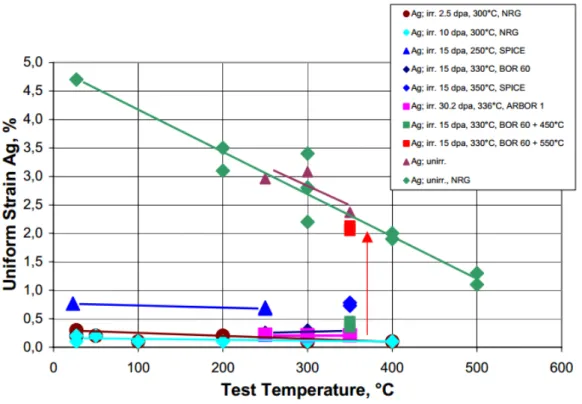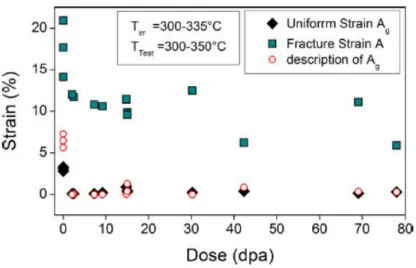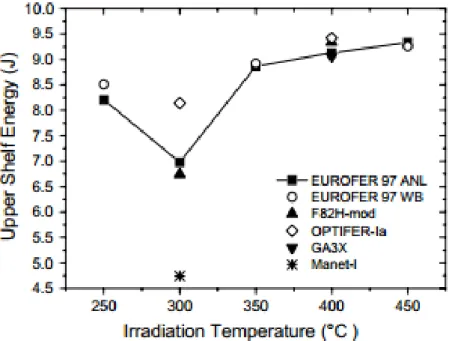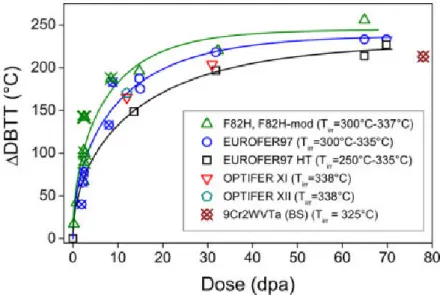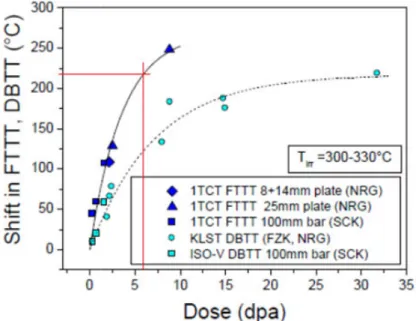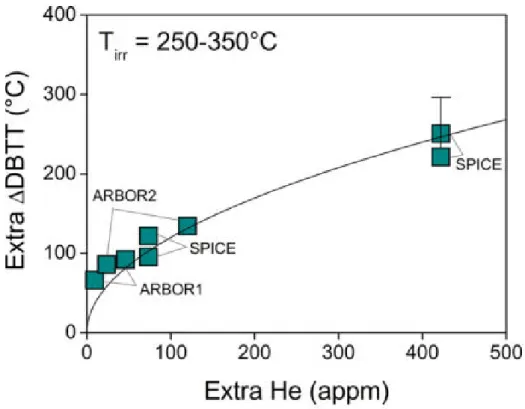APPLICATION OF EUROFER97 STEELS
FOR DEMO DIVERTOR CASSETTE
IRRADIATED AT TEMPERATURE
BELOW 350 °C
D. DE MEIS, G. MAZZONE Fusion and Technology for Nuclear Safety and Security Department
FrascatiResearch Centre
RT/2016/21/ENEA
ITALIAN NATIONAL AGENCY FOR NEW TECHNOLOGIES, ENERGY AND SUSTAINABLE ECONOMIC DEVELOPMENT
D. DE MEIS, G. MAZZONE
Fusion and Technology for Nuclear Safety and Security Department Frascati Research Centre
APPLICATION OF EUROFER97 STEELS
FOR DEMO DIVERTOR CASSETTE
IRRADIATED AT TEMPERATURE
BELOW 350 °C
RT/2016/21/ENEA
ITALIAN NATIONAL AGENCY FOR NEW TECHNOLOGIES, ENERGY AND SUSTAINABLE ECONOMIC DEVELOPMENT
I rapporti tecnici sono scaricabili in formato pdf dal sito web ENEA alla pagina http://www.enea.it/it/produzione-scientifica/rapporti-tecnici
I contenuti tecnico-scientifici dei rapporti tecnici dell’ENEA rispecchiano l’opinione degli autori e non necessariamente quella dell’Agenzia
The technical and scientific contents of these reports express the opinion of the authors but not necessarily the opinion of ENEA.
APPLICATION OF EUROFER97 STEELS FOR DEMO DIVERTOR CASSETTE IRRADIATED AT TEMPERATURE BELOW 350 °C
D. De Meis, G. Mazzone Riassunto
L'acciaio inossidabile austenitico AISI 316 L(N) IG è utilizzato come materiale strutturale per i principali componenti in-vessel di ITER. Quando le fluenze neutroniche aumentano come nei componenti in-vessel di DEMO, non è possibile utilizzare l’AISI 316 in quanto è soggetto a forte attivazione a causa dell'elevata presenza di Nichel. Devono essere previsti acciai ferritici/martensitici ad attivazione ridotta come l’Eurofer97 che mantengono buone proprietà thermo-meccaniche e stabilità dimensionale sotto irraggiamento (i.e. resitenza al rigonfiamento).
L'obiettivo principale del presente lavoro è quello di evidenziare lo stato dell’arte circa le proprietà meccaniche dell’Eurofer97 irraggiato a temperature al di sotto di 350 °C.
In base ai dati raccolti, è discussa la fattibilità per applicazioni strutturali dell’Eurofer97 e degli acciai ferritici/martensitici nel caso di impiego dell’acqua come fluido refrigerante per la cassetta del divertore. Questo rapporto a questo stadio non tiene conto degli impatti della corrosione sugli acciai RAFMs che sono probabilmente meno critici degli effetti dell’infragilimento da irraggiamento. Parole chiave: Eurofer97, RAFMs, DEMO, cassetta del divertore, fluenze neutroniche, DBTT
Abstract
The austenitic stainless steel AISI 316 L(N) IG is used as structural material for the main ITER in-vessel components. When neutron fluences increase, as in DEMO in-vessel components, it is not possible to use AISI 316, which is subject to strong activation due to its high nickel content. Ferritic/martensitic steels with reduced activation properties as Eurofer97 which keep good thermo-mechanical properties and good dimensional stability under irradiation (i.e. resistance to swelling), must be envisaged.
The principal objective of the present paper is to address the current status about the mechanical properties of Eurofer97 irradiated at temperature below 350 °C.
Based on the collected data, the feasibility of Eurofer97 and Reduced Activation Ferritic/Martensi-tic (RAFM) steels for structural applications is discussed in case of using water as coolant for divertor cassette. This report at this stage does not account for corrosion-related impacts on RAFMs behavior, which are likely less critical than irradiation embrittlement effects.
1. Introduction
2. Eurofer97 properties
3. Tensile properties 4. Impact properties
5. Fracture Mechanical properties of Eurofer97
6. Helium effect 7. DBTT and FTTT of Eurofer97 irradiated at 6 dpa with 14 Mev neutrons 8. Conclusions Acknowledgements References 7 8 9 12 15 15 18 19 19 19
INDEX
7 1. Introduction
Reduced activation Eurofer97 and RAFM steels are the primary choice materials for first wall and breeding blanket for future fusion power plants (Gaganidze 2013, Zinkle 2013, De Meis 2015). This because metals and alloys with “Body-centred cubic (Bcc)” crystal lattice structure, including iron and ferritic steels, show better resistance to prolonged irradiation than metals with “Face-centred-cubic (Fcc)” lattices (EFDA 2012).
A comparison of the swelling behavior under fission irradiation for ferritic steels against austenitic steels is shown in fig. 1.
Fig. 1 Comparative swelling behavior under fission neutron irradiation for ferritic and austenitic steels (EFDA 2012)
In this paper we will consider the use of Eurofer97 and RAFM steels for structural application in case of using water as coolant for divertor cassette. In particular the water inlet/outlet temperatures is below 350 °C (EFDA 2013).
A CAD contour model of the current DEMO divertor cassette design (as of 2015) is illustrated in fig. 2.
Neutron irradiation of Eurofer in the temperature below 350 °C results in strong degradation of mechanical properties (in particular strong hardening and loss of ductility) (Baluc 2004). In particular with neutron irradiation on Eurofer97:
-DBTT will be raised above room temperature already after few dpa;
-Upper Shelf Energy (USE) will be reduced in comparison with the unirradiated state;
8
Fig. 2 CAD of DEMO divertor cassette as of 2015
2. Eurofer97 properties
Lot’s information on Eurofer97 can be found in (Aiello 2011, De Meis 2015). Table 1 (Gaganidze 2007) reports steels’ chemical composition.
Table 1 Materials chemical composition
Starting from these reference steels, attempts have been made to develop RAFM versions with improved resistance to irradiation embrittlement by modifying their chemical compositions and/or thermal treatments. Work on Eurofer97 to this purpose has been performed within the frame of the previous EFDA Materials Programs (i.e. Eurofer WB, Gaganidze 2007) and is now pursued under the
9
Materials Work Package (WPMAT) of EUROfusion. On the other hand, F82H mod melts with superior embrittlement properties have been successfully produced as a results of Japan-US collaboration activities (Okubo, 2011). The Japan-US studies demonstrated that appropriate heat treatments, addition of Ta and/or reduction of N and Ti could reduce the irradiation embrittlement.
Table 2 (Gaganidze 2007) lists the heat treatment conditions along with selected properties of the materials.
Table 2 Heat treatment and selected properties of unirradiated materials
3. Tensile properties
Fig. 3(a) shows engineering stress strain curves of Japanese JLF1 ferritic/martensitic steel before and after irradiation to 4,8 dpa. Fig. 3(b) shows the damage level dependence of yield stress of F82H (Japanese ferritic/martensitic) (Jitsukawa, 2004).
Fig. 3 Tensile properties of JLF-1 and F82H after irradiation
10
condition and after neutron irradiation in different medium and high dose European irradiation programmes at target irradiation temperature (Tirr) between 250 and 350 °C.
Fig. 4 Yield Stress (Rp02) of irradiated Eurofer97 vs test temperature
Neutron irradiation leads to a substantial increase in the Yield Stress which is sensitive to irradiation dose and temperature.
The evolution of the hardening with damage dose is summarized in fig. 5 (Gaganidze 2013).
Fig. 5 Irradiation hardening vs irradiation dose for Eurofer and other RAFM steels
Neutron irradiation leads to a substantial increase in the Yield Stress of RAFM steels with the damage dose. The Yield Stress increase is rather steep at doses below 10 dpa. The hardening rate appears to be
11
significantly decreased at the achieved damage doses and a clear tendency towards saturation is identified.
For the analysis of high dose irradiation behavior of EUROFER97 differentiation has to be done between different product forms as well as different heat treatment conditions. In fact there is a strong sensitivity of materials’ mechanical properties and irradiation performance to metallurgical parameters. The hatched area marks the scattering band of high dose hardening for different RAFM steels.
It is important to note that the reasons for the data scattering belong not only the differences in the metallurgical variables, but also variations and uncertainties in the irradiation conditions.
Fig. 6 (Petersen 2006) shows the decrease of Uniform Strain with increasing irradiation damage. Rather low values of the Uniform Strains below 1% are observed for all investigated RAFM steel.
Fig. 6 Uniform Strain (Ag) behavior of irradiated Eurofer97 vs test temperature
The evolution of Strain with irradiation dose for different product forms of EUROFER97 for irradiation temperatures between 300 and 335 °C and test temperatures between 300 and 350 °C is shown in Fig. 7. The both tensile properties show a strong reduction from their values in the reference unirradiated state already at a damage dose of 2.1 dpa. The Uniform Strain (Ag) is scattered mostly below 0.5% in the irradiated state. Though strongly reduced, the Fracture Strain (A) remains mostly at or above 10% for irradiated specimens.
12
Fig. 7 Uniform and fracture strain vs damage dose for different product forms of Eurofer97 (Gaganidze 2013)
4. Impact properties
The role of irradiation temperature on the impact properties of EUROFER97 and other RAFM steels was studied in SPICE program.
In fig. 8 (Gaganidze 2007) is illustrated the impact energy vs. test temperature.
13
Fig. 9 (Gaganidze 2007) shows the USE of Eurofer97 at different neutron irradiation temperature.
Fig. 9 Upper shelf energy (J) vs irradiation temperature (°C)
The following figure 10 (Petersen 2006) shows the impact properties of Eurofer unirradiated and irradiated.
Fig. 10 Impact properties of unirradiated and irradiated of BS Eurofer (which is a British steel batch of Eurofer97 ordered by NRG)
14
Fig. 11 (Gaganizde 2013) shows the DBTT vs irradiation temperature for Eurofer97 and other RAFM steels. The DBTT is influenced most at low irradiation temperature (T irr <330).
Fig. 11 DBTT vs irradiation temperature for selected RAFM steels from SPICE tests (average damage dose in Spice was 16.3 dpa)
Fig.12 (Gaganidze 2013) shows the evolution of the neutron irradiation induced embrittlement with dose at different irradiation temperatures. All RAFM steels show increase in the ∆ DBTT with dose below 15 dpa.
In case of EUROFER97, differentiation is made between specimens machined from as products and specimens machined from the plates subjected to pre
results on F82H and F82H-mod are plott
compositions. The pre-irradiation heat treatment (HT) of Eurofer97 leads to considerable improvement of the irradiation resistance at doses up to 30 dpa. At the achieved damage doses, however, the embrittlement of Eurofer97 HT becomes comparable to that of Eufofer97. All RAFM steels show
steep increase in the ∆DBTT with dose below 15 dpa. With further increasing the damage dose the
embrittlement rate decreases and a clear tendency towards saturation is damage doses.
5. Fracture Mechanical properties of Eurofer97
Fig. 13 shows the neutron irradiation induced shift in FTTT (Fracture Toughness Transition Temperature) and KLST (specimen according to DIN 50 115) and ISO
irradiation dose. Irradiation induced shifts in FTTT are significantly larger than shifts in Charpy DBTT which indicates a non conservative estimations on the embrittlement by Charpy test.
Fig. 13 Irradiation induced shift in FTTT and KLST (Gaganidze 2013)
6. Helium effect
There is significant uncertainty regarding the magnitude of additional embrittlement that might be
15
In case of EUROFER97, differentiation is made between specimens machined from as
products and specimens machined from the plates subjected to pre-irradiation heat treatment (HT). The mod are plotted together for different heat treatments and material irradiation heat treatment (HT) of Eurofer97 leads to considerable improvement of the irradiation resistance at doses up to 30 dpa. At the achieved damage doses, however, the ittlement of Eurofer97 HT becomes comparable to that of Eufofer97. All RAFM steels show DBTT with dose below 15 dpa. With further increasing the damage dose the embrittlement rate decreases and a clear tendency towards saturation is observed at the achieved
5. Fracture Mechanical properties of Eurofer97
Fig. 13 shows the neutron irradiation induced shift in FTTT (Fracture Toughness Transition Temperature) and KLST (specimen according to DIN 50 115) and ISO-V DBTT for
irradiation dose. Irradiation induced shifts in FTTT are significantly larger than shifts in Charpy DBTT which indicates a non conservative estimations on the embrittlement by Charpy test.
Fig. 13 Irradiation induced shift in FTTT and KLST and ISO-V DBTT for Eurofer97
There is significant uncertainty regarding the magnitude of additional embrittlement that might be In case of EUROFER97, differentiation is made between specimens machined from as-delivered irradiation heat treatment (HT). The ed together for different heat treatments and material irradiation heat treatment (HT) of Eurofer97 leads to considerable improvement of the irradiation resistance at doses up to 30 dpa. At the achieved damage doses, however, the ittlement of Eurofer97 HT becomes comparable to that of Eufofer97. All RAFM steels show DBTT with dose below 15 dpa. With further increasing the damage dose the observed at the achieved
Fig. 13 shows the neutron irradiation induced shift in FTTT (Fracture Toughness Transition V DBTT for Eurofer97 vs irradiation dose. Irradiation induced shifts in FTTT are significantly larger than shifts in Charpy DBTT which indicates a non conservative estimations on the embrittlement by Charpy test.
V DBTT for Eurofer97
16
introduced during fusion-relevant neutron irradiation that would generate ~ 10 appm He/dpa in steels due to helium-induced hardening.
Experiments based on neutron-irradiated B-doped RAFM steels (where additional He generation is controlled by boron transmutation) indicate the increase in DBTT from He can approach or exceed the DBTT increase associated with radiation hardening at 250-350 °C.
Fig. 14 (Gaganidze 2013) shows the additional increment of DBTT increase attributable to He production following fission neutron irradiation of B-doped Eurofer97 steels.
Fig. 14 Helium induced extra embrittlement vs extra helium amount for irradiated boron doped steels.
The influence of the irradiation temperature on the embrittlement of boron doped steels is shown in fig 15 (Gaganidze 2013).
Fig. 16 (Gaganidze 2013) shows the post irradiated annealing of Eurofer97 leads to a recovery of the impact properties with respect to DBTT and upper shelf energy (ADS2= 24 appm He) ADS3= 120 appm He). The post-irradiation annealing leads to substantial recovery of the impact properties. The post-irradiation annealing of e.g. 70 dpa irradiated EUROFER97 HT at 550 °C for 3 h leads to a reduction of the DBTT from 135 to -43 °C resulting in a residual embrittlement (shift in DBTT) of just 48 °C compared to the unirradiated state.
17
Fig. 15 DBTT vs irradiation temperature for boron-doped an base Eurofer97 steels after irradiation in SPICE programme to volume average damage dose of 16,3 dpa. (For Eurofer97 ANL and WB see table 2).
Fig. 16 Impact energy vs test temperature in unirradiated (open symbols), after irradiation to 69,8 dpa at 332-338 °C (solid symbols) and after post irradiation annealing at 550 °C for 3 h (crossed symbols). (In specimens labeled Eurofer97 HT in addition to a heat treatment (HT) by the producer at (980 °C/0.5 h + 760 °C/1.5 h), they were subjected to a laboratory-scale pre-irradiation HT of (1040 °C/38 min + 750 °C/2h).
18
7. DBTT and FTTT of Eurofer irradiated at 6 dpa with 14 Mev neutrons
In DEMO it is assumed that the divertor cassette should be replaced after no more than 2 full power years (fpy). A neutronic calculation (2MXM8G_v1_1) has determined the maximum irradiation damage level in the structural material of the cassette body as 6 dpa after 2fpy. The corresponding Helium production in Eurofer was determined to be ~100appm.
It can be assumed that the ductile-to-brittle (DBTT) measured in dynamical Charpy impact tests and the fracture toughness (FTTT) transition temperatures quantified in quasi-static fracture-mechanical tests are correlated but experimental results show that the two transition temperatures differ to some degree.
The DBTT of Eurofer varies with the batch number and product form. For the 1st batch of Eurofer
(EUROFER97-1) the average DBTT is about -80 °C (see figs. 10 and 11).
The FTTT of Eurofer also varies with the batch number and product form. In addition, there is an additional uncertainty in FTTT imposed by application of the standard Master Curve methodology. For the first batch of Eurofer the FTTT is about -108 °C. Application of the modified Master Curve procedure (Mueller 2009) yields considerably higher transition temperature of -78°C. However, since the modified master curve methodology has not been validated yet in the irradiated state, FTTT of -108 °C in the un-irradiated condition is considered here.
Post-irradiation assessment both DBTT and FTTT concludes the following regarding the shift of the Transition Temperature after irradiation at 6 dpa:
- according to fig. 12 the DBTT of Eurofer shifts from the un-irradiated level at ~-80°C by ~123K to ~43°C;
- according to Fig. 13 the FTTT of Eurofer shifts from the un-irradiated level at ~-108°C by ~225K to ~117°C.
However since Fig. 12 and Fig. 13 are based on material samples irradiated in fission reactors, Helium production in the material that will occur due to irradiation with high energy neutrons generated in the fusion reaction is not taken into account. In (Gaganidze 2013) a DBTT shift in the range 0.5 - 0.6 K/appm He is estimated on the base of Charpy impact experiments on boron doped model steels. Hence for our case of 100 appm He an additional shift of the DBTT of 50-60K is expected. Corresponding examinations of helium effects on the FTTT shift are not known to the authors and are assumed here to be of similar magnitude. This assumption needs to be validated in future but is assumed to be conservative.
Hence for an irradiation damage of 6 dpa the DBTT of Eurofer would be at ~100°C, the FTTT at ~ 180°C.
19 8. Conclusions
We have summarized all mechanical properties of Eurofer97 steel under irradiation at temperature below 350 °C.
In case we don’t take into account the embrittlement due to helium production the standard Master Curve methodology yields FTTT of about 120 °C for Eurofer at 6 dpa. In this case the divertor cassette can be cooled with water at a temperature of about 150°C.
In case we consider also the embrittlement due to helium production, under assumption of helium embrittlement rate on FTTT is comparable to the embrittlement rate quantified in impact experiments, the FTTT of about 180°C is estimated for Eurofer at 6 dpa. In this case the cooling water should be about 200 °C.
Attention has to be taken for normal and abnormal shut down particularly where the temperature goes below FTTT of irradiated Eurofer97 steel.
Post irradiation annealing at 550 °C for 3 h, prior to reactor cool down, can be utilized to avoid handling of brittle cassette. In fact this thermal treatment leads to nearly complete recovery of the impact and tensile properties of low temperature irradiated Eurofer97 indicating substantial healing of radiation defects. Helium effects cannot be healed out by post irradiation annealing (Gaganidze, 2013).
Acknowledgments
We thank all colleagues for their help and support. In particular we would like to thank Dr. E. Gaganidze and Dr. M. F. Maday for their contributions and very careful and extensive revision.
References
E. Gaganidze et alii “Assessment of neutron irradiation effects on RAFM steels”, Fusion Engineering and design 88 (2013)
S.J. Zinkle “Multimodal options for materials research to advance the basis for fusion energy in ITER era”, Nuclear Fusion 53 (2013) 104024
D. De Meis “Structural Materials for DEMO, RT/2015/25/ENEA, 2015
EFDA 2012, D_2MJ5EU “Assessment of the EU R&D programme on Demo structural and high-heat flux materials”
EFDA 2013, 2KXQA6 “Issues related to radiation on blanket and divertor materials”
20
reactor” Nuclear Fusion 44 (2004) 56-61
G. Aiello et alii “ Assessment of design limits and criteria requirements for Eurofer structures in TBM components”, Journal of nuclear materials 414 (2011) 53-68
E. Gaganidze et alii “ Embrittlement behavior of neutron irradiated RAFM steels”, Journal pf Nuclear Materials 367-370 (2007) 81-85
N. Okubo et alii, “Heat treatment effect on fracture thoughness of F82H irradiated in HFIR”, Journal of Nuclear Materials, 417, 2011
S. Jitsukawa et alii “Progress of reduced activation ferritic/martensitic steel development in Japan”, 2004
C. Petersen et alii “Mechanical properties of reduced activation ferritic/martensitic steels after European reactor irradiations”, 2006
WP-DIV-Neutronics_loads_assessment_2015_2MXM8G_v1_1
P. Mueller et alii, “Fracture toughness master-curve analysis of the tempered martensitic steel Eurofer97”, JNM 386-388 (2009)
ENEA
Servizio Promozione e Comunicazione
www.enea.it
Stampa: Laboratorio Tecnografico ENEA - C.R. Frascati luglio 2016




